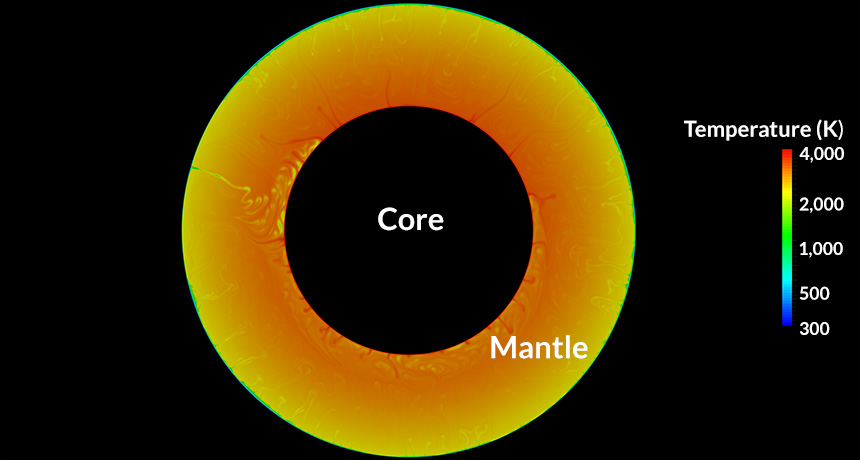Earth’s tectonic plates won’t slide forever
In a few billion years they’ll grind to a halt

Snapshot from a computer simulation that was calculated to model how heat flows through a planet’s interior. It comes from a time showing active plate tectonics. Those plates will stop sliding across Earth’s mantle, researchers predict. But not for a few billion years.
C. O’NEILL ET AL/PHYS. EARTH PLAN. INT. 2016
Slowly, slowly, Earth’s crust — what we think of as its surface — reshapes itself. This has been going on month after month, year after year. It started several billion years ago. It won’t continue forever, however. That’s the conclusion of a new study.
Earth’s surface rock (and the soil or sand above it) moves slowly atop shifting rocky slabs known as tectonic plates. Some plates collide, putting pressure on the edges of a neighbor. Their thrusting movement can lead to an upheaval of those edges — and the formation of mountains. In other places, one plate may slowly slide beneath a neighbor. But a new study argues that these movements of the tectonic plates could be a passing phase in our planet’s history.
After using computers to model the flow of rock and heat flow throughout Earth’s lifetime, scientists now now conclude that plate tectonics is just one temporary stage of a planet’s life cycle.
The computer model showed that in Earth’s youth, its interior was too hot and runny to push around the giant chunks of crust. After the planet’s interior cooled for some 400 million years, tectonic plates began shifting and sinking. This process was stop-and-go for about 2 billion years. The computer model suggests that Earth now is almost halfway through its tectonic life cycle, says Craig O’Neill. He’s a planetary scientist at Macquarie University in Sydney, Australia. In another 5 billion years or so, as the planet chills, plate tectonics will grind to a halt.
O’Neill and his colleagues report their conclusion in a paper in the June Physics of the Earth and Planetary Interiors.
Tectonics on Earth and beyond
It took billions of years before full-blown, nonstop plate activity was busy remodeling Earth’s surface. That early delay hints that tectonics might one day kick start on what are now stagnant planets, says Julian Lowman, who was not involved in the research. Lowman works at the University of Toronto, Canada. There, he studies Earth’s tectonic activity. He now suspects that there is a chance “that plate tectonics could start up on Venus.”
HOT TO COLD The young Earth was too hot for plate tectonics, computer calculations now suggest. For a few hundred million years, the planet’s crust was stagnant. And one day it will be again — but this time because Earth has cooled too much. C. O’NEILL ET AL/PHYS. EARTH PLAN. INT. 2016 |
However, he adds, that’s only if the conditions are just right.
The intense heat flowing through Earth’s interior drives the motions of tectonic plates. Simulating that heat flow requires a computer to make complex calculations. Previous attempts to do that were too simple. They also typically looked only at brief snapshots of Earth’s history. And that, O’Neill suspects, is why they likely missed how plate tectonics has been changing over time.
The new computer model predicted Earth’s tectonic motions. It started its analyses from the time of the planet’s formation, some 4.5 billion years ago. Then the model looked ahead some 10 billion years. Even using a supercomputer and simplifying how they modeled the planet, these calculations took weeks.
The new timeline suggests that plate tectonics is just a midpoint between two stagnant states in Earth’s evolution. Planets that started off with a different starting temperature would likely enter or end their tectonic period at a different pace than Earth’s, the researchers now conclude. Colder planets may exhibit plate tectonics throughout their history while hotter planets might go billions of years without it.
Plate tectonics regulates a planet’s climate. It does this by adding and removing carbon dioxide from the atmosphere. This climate control has helped maintain Earth’s ability to support life. But lacking plate action does not mean a planet cannot support life, O’Neill says. Life may have emerged on Earth roughly 4.1 billion years ago. Back then, full-blown plate tectonics was not yet fully underway, the new computer model finds. “Depending on when they are in their history,” O’Neill says, stagnant planets may be as likely to support life as are those with moving plates.







